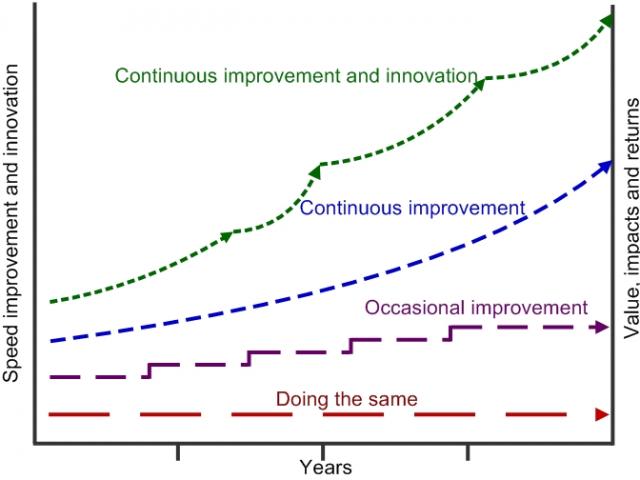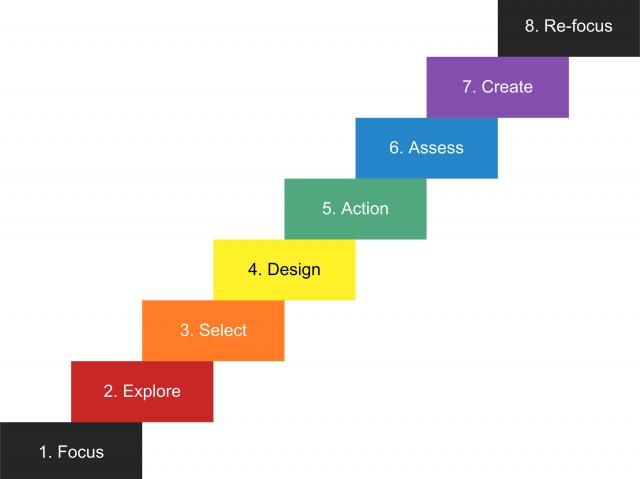There are a range of tools to support CI&I. These are available in the Business improvement toolbox.
The CI&I process is about achieving regular and frequent improvements and innovations that contribute directly to the goals of the business. Figure 1 shows how the returns from CI&I are expected to be higher than from other approaches. The red line shows 'business as usual'. In today’s rapidly changing world if all we do is what we have always done, we are likely to fall behind the game. The purple line shows the stepwise impact that can be expected from occasional improvement. The blue line shows the steady impact that can be expected from continuous improvement. The green line shows the increase in returns that is possible from successful continuous improvement and innovation.

Figure 2 shows the eight steps of the CI&I process. A brief description of each step and the tools that can be used, are given after Figure 2. For each step, one or more tools can be used depending on the needs of the business.
Step 1: Focus
This step is about focusing on the end results that we want. It involves developing outcome-based goals. It is useful to have short, medium and long term goals. Step 1 is also about working out the measures that will be used to track performance.
Tools available for this step:
Step 2: Explore
This step is about finding ways to achieve the goals that were set in step 1. Where possible it is good to develop a range of options. Using different types of thinking, such as creative thinking, can help to come up with ideas we may not normally think of.
Tools available for this step:
Step 3: Select
This step is about selecting the best options from the ones identified in step 2. Just as importantly, it is about putting aside options that are not a high priority. This step also provides predictions about the results to expect from the chosen options.
Tools available for this step:
- Impact and influence
- Eight criteria technique
- Gross margin analysis
- Benefit cost analysis.
Step 4: Design
This step is about designing the action you need to take to successfully implement the options chosen in step 3. It can include setting up small scale trials if needed. Step 4 is also about putting in place measures to track implementation and performance.
Tools available for this step:
- Action design tool
- Five Ws and one H
- Critical success factors (CSFs) and key performance indicators (KPIs)
- Force field analysis.
Step 5: Action
This step is about implementing the action you designed in step 4 and tracking performance. It is also about getting regular support to keep motivated and stay on track.
Tools available for this step:
- Action design tool - this step uses the design developed in Step 4
- Five Ws and one H - this step uses the plan developed in step 4
- Critical success factors (CSFs) and key performance indicators (KPIs) - this step uses the measures developed in earlier steps.
Step 6: Assess
This step is about assessing the results achieved in step 5 with the results that were predicted in step 3. It is also about looking at the overall impact on the goal developed in step 1. Step 6 is also about looking at unexpected things that happened.
Tools available for this step:
- SMARTT goal - this step assesses results to the goals developed in earlier steps
- Critical success factors (CSFs) and key performance indicators (KPIs) - this step assesses results to the CSFs and KPIs developed in earlier steps
- Gross margin analysis - this step uses gross margin analysis to assess the results achieved with those that were expected
- Benefit cost analysis.
Step 7: Create
As a result of steps 1 to 6, a lot has been learnt and a new situation exists where more improvements may be possible. Step 7 is about asking questions and coming up with ideas for further improvements. Different types of thinking are used in this step to stimulate creativity.
Tools available for this step:
- Brainstorming
- Inverse thinking
- Observations, questions, ideas and opportunities.
Step 8: Re-focus
Step 8 is about turning one or two of the ideas for further improvement developed in step 7, into specific improvement goals, as was done in step 1.
Tools available for this step:

